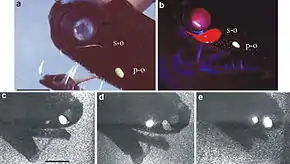Malacosteus niger
Malacosteus niger is a species of fish in the family Stomiidae, the barbeled dragonfishes. It is known by the common names northern stoplight loosejaw, lightless loosejaw, black loosejaw, and black hinged-head.[1] It lives in oceans around the world from tropical to subarctic waters where it feeds primarily on zooplankton, but is also known to consume piscivores.[1] Its unique visual and bioluminescence permit it to see the red light produced by its photophores which most other species cannot perceive, thus making M. niger an apex predator in its ecosystem.

| Malacosteus niger | |
|---|---|
 | |
| Scientific classification | |
| Kingdom: | |
| Phylum: | |
| Class: | |
| Order: | |
| Family: | |
| Genus: | |
| Species: | M. niger |
| Binomial name | |
| Malacosteus niger Ayres, 1848 | |
| Synonyms | |
Anatomy and Physiology
Visual System
Malacosteus niger has yellow lenses that are believed to improve the functionality of the perception of their red bioluminescence. M. niger has adapted a retinal structure of "ten layer elements," similar to those found in surface-level species and other shallow-water living species — which also perceive red light.[2] Its retina is made up entirely of rods and no cones, with rhodopsin/porphyropsin pairs and a single opsin bound to some of its photoreceptors, which provide visual sensitivity up to 517-541 nm (this falls within the wavelength of red light).[3] For comparison, other red light producing stomiids, such as Aristostomias and Pachystostomias, have a third pigment which allows them to perceive light up to 588 nm and 595 nm respectively. The yellow lens reduce the amount of blue light that reaches the retina and increases sensitivity to longer wavelengths, which benefits M. niger and its red bioluminescence.
Yellow lens have also been identified in Echiostoma, which also produces red bioluminescence.
Morphology
M. niger is unique from other stomiid genera because its jaw is over 30% its whole body length (average adult length of 24cm according to the Australian Museum), which aids in catching larger prey.[4] Its jaw is also made up of large, fang-like teeth, its lower-jaw lacks a floor to the oral cavity, and it can open its jaw greater than 120˚.[4] The lack of a floor of to the oral cavity allows for decreased resistive forces which allows M. niger to close its mouth rapidly and easily trap its prey. This adaptation also minimizes the amount of energy required for M. niger to close its mouth, thus permitting it to quickly latch onto fast-swimming prey.[4]
The postorbital photophore in this species is larger than in M. australis. It also differs in lateral photophore count, as well as in morphological characters. The maximum known length is 25.6 cm (10.1 in). Its specific epithet niger is Latin for "black".[5]
Ecological and Geographical Distribution
Malacosteus niger has been documented inhabiting the North Atlantic, the Gulf of Mexico, and throughout the Pacific Ocean.[6] It occurs in the mesopelagic zone of all oceans.[7] Contrary to barbeled dragonfishes in general, it is not a vertical migrator.
Diet
While the morphology of M. niger with huge fangs and an enormous gape is typical for its family and suggests adaptations to piscivory, its diet in fact contains a substantial proportion of zooplankton.[8] Some of its documented prey include calanoid copepods, micronekton, decapod shrimps, and other decapods.[6] M. niger digests its prey within a diel cycle, meaning the copepods it consumes at nighttime are digested by the afternoon the following day, which requires it to be constantly feeding on these small prey to sustain its energy; copepods make up 69-83% of its diet.[6] It is suggested that its dominant feeding mode is searching for zooplanktonic prey (copepods in particular) using bioluminescence to illuminate a small search area, with infrequent encounters with larger prey items. The likely origin of the pigment necessary for detecting its long wavelength bioluminescence, a chlorophyll derivative, is the copepods themselves.[8][9]
Red Bioluminescence
M niger's unique adaptation of producing red bioluminescence is only found in two other deep-sea dwelling creatures, Aristostomias and Pachystomias. This rare form of bioluminescence can reach up to 700 nm in the deep-sea and cannot be perceived by green and blue bioluminescent organisms, thus granting M. niger a considerable advantage while hunting for food.[3]
References
- Harold, A. 2015. Malacosteus niger. The IUCN Red List of Threatened Species. Downloaded on 20 February 2016.
- "'Yellow lens' eyes of a stomiatoid deep-sea fish, Malacosteus niger". Proceedings of the Royal Society of London. Series B. Biological Sciences. 215 (1201): 481–489. 1982-07-22. doi:10.1098/rspb.1982.0055. ISSN 0080-4649.
- Douglas, R.H; Partridge, J.C; Dulai, K.S; Hunt, D.M; Mullineaux, C.W; Hynninen, P.H (August 1999). "Enhanced retinal longwave sensitivity using a chlorophyll-derived photosensitiser in Malacosteus niger, a deep-sea dragon fish with far red bioluminescence". Vision Research. 39 (17): 2817–2832. doi:10.1016/S0042-6989(98)00332-0.
- Kenaley, Christopher P. (May 2012). "Exploring feeding behaviour in deep-sea dragonfishes (Teleostei: Stomiidae): jaw biomechanics and functional significance of a loosejaw: DRAGONFISH FEEDING BIOMECHANICS". Biological Journal of the Linnean Society. 106 (1): 224–240. doi:10.1111/j.1095-8312.2012.01854.x.
- Kenaley, C.P. (2007). "Revision of the Stoplight Loosejaw Genus Malacosteus (Teleostei: Stomiidae: Malacosteinae), with Description of a New Species from the Temperate Southern Hemisphere and Indian Ocean". Copeia. 2007 (4): 886–900. doi:10.1643/0045-8511(2007)7[886:ROTSLG]2.0.CO;2.
- Sutton, Tracey T. (2005-11-01). "Trophic ecology of the deep-sea fish Malacosteus niger (Pisces: Stomiidae): An enigmatic feeding ecology to facilitate a unique visual system?". Deep Sea Research Part I: Oceanographic Research Papers. 52 (11): 2065–2076. doi:10.1016/j.dsr.2005.06.011. ISSN 0967-0637.
- Froese, Rainer and Pauly, Daniel, eds. (2012). "Malacosteus niger" in FishBase. February 2012 version.
- Sutton, T. T. (2005). "Trophic ecology of the deep-sea fish Malacosteus niger (Pisces: Stomiidae): An enigmatic feeding ecology to facilitate a unique visual system?". Deep-Sea Research Part I: Oceanographic Research Papers. 52 (11): 2065–2076. doi:10.1016/j.dsr.2005.06.011.
- Herring, P.J.; Cope, A. (December 2005). "Red bioluminescence in fishes: on the suborbital photophores of Malacosteus, Pachystomias and Aristostomias". Marine Biology. 148 (2): 383–394. doi:10.1007/s00227-005-0085-3.
